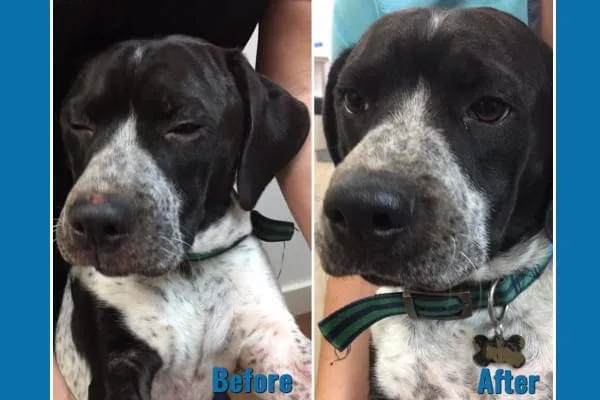Are you searching for everything you need to know about effective anti-itch medication for dogs? Help is here. Integrative veterinarian Dr. Julie Buzby guides you through the signs, symptoms, and treatment options for canine allergies, including the latest on newer anti-itch medications such as Apoquel® and Cytopoint®.
 Senior dog rubbing face with paws, a classic sign of allergies, resting in green grass and dandelions
Senior dog rubbing face with paws, a classic sign of allergies, resting in green grass and dandelions
Allergies are a very common problem in dogs, causing incessant itching and discomfort. But that doesn’t make it any easier for you or your beloved canine companion who is suffering.
Thankfully, veterinary medicine now offers more to our itchy canine companions than Benadryl® and prednisone, which were the primary anti-itch medications for dogs in prior decades. There are newer veterinary-prescribed medications like Apoquel and Cytopoint that can quickly quell the itch, significantly improving your dog’s quality of life.
By the end of this article, you’ll have a comprehensive list of 10 solutions for dogs with allergies that includes Benadryl, Apoquel, and Cytopoint.
What Are Dogs Allergic To?
Before we can discuss strategies to manage itching in dogs, we first need to understand the types of allergies dogs suffer from. Dog allergies typically fall into three main categories:
- Environmental allergies
- Food allergies
- Flea allergies
Dogs can be allergic to many of the same things that trigger allergies in humans, leading to persistent itching and discomfort.
1. Environmental Allergies in Dogs
Environmental allergies, also known as seasonal allergies, atopy, or atopic dermatitis, are precisely what the name indicates—allergies to components of your dog’s environment. The most common environmental allergens that cause itching include:
- Tree pollen
- Weed pollen
- Grass pollen
- Dust mites
- Mold and mildew
While these are the most common, dogs can also be allergic to other environmental substances. Your dog may show allergy symptoms, including severe itching, only part of the year when certain pollen counts are high. Alternatively, if your dog has allergies to multiple pollens or to indoor allergens, he or she may be symptomatic and itchy year-round.
2. Food Allergies in Dogs
Food allergies, also known as cutaneous adverse food reactions (CAFR), occur when your dog’s immune system mistakenly identifies certain foods or ingredients as allergens. A variety of foods have been implicated in food allergies in dogs. The most common culprits that can lead to itching and other skin issues are beef, chicken, lamb, and wheat.
Dogs typically develop allergies to foods they have been consuming for a while (months to years). It is much less common for them to start showing food allergy signs, such as itching, immediately after starting a new food.
3. Flea Allergies in Dogs
Dogs with flea allergies (flea allergy dermatitis or FAD) are not simply allergic to the presence of fleas. Rather, they are highly sensitive to the flea’s saliva, which is deposited in the skin when it bites the dog. This means that even a few flea bites can make a flea-allergic dog significantly itchy, often leading to intense scratching and discomfort. Effective flea prevention is a crucial component of anti-itch medication for dogs with this type of allergy.
Itching in Dogs Often Requires a Combination of Anti-Itch Medication and Treatments
To further complicate matters, a dog may suffer from one, two, or all three of these types of allergies. The symptoms of these allergies, especially itching, have a cumulative effect. This is why your veterinarian may treat your dog with a combination of anti-itch medications for dogs, dietary changes, and other strategies, especially if your dog has more than one type of allergy. Sadly, there is no single “magic bullet” that works in all cases all the time for alleviating canine itching.
 A Golden Retriever dog rubbing face in the grass, a classic sign that the dog may need anti-itch medication for dogsA dog rubbing his face in the grass or on the carpet is a classic allergy symptom, often indicating a need for anti-itch medication for dogs.
A Golden Retriever dog rubbing face in the grass, a classic sign that the dog may need anti-itch medication for dogsA dog rubbing his face in the grass or on the carpet is a classic allergy symptom, often indicating a need for anti-itch medication for dogs.
What Are the Symptoms of Skin Allergies in Dogs?
Dogs with food, flea, or environmental allergies (or a combination of these allergies) tend to exhibit similar signs, primarily centered around skin irritation and itching. Some of the common symptoms of allergies in dogs include:
- Itchy ears that are prone to infections, often requiring specific anti-itch treatments.
- Licking or gnawing at feet and legs due to itchy paws.
- Incessant scratching of the armpits, belly, face, base of the tail, or seemingly everywhere, indicating the need for anti-itch medication.
- Red, irritated skin that is prone to yeast or bacterial infections (pyoderma in dogs), which can worsen itching.
- Frequently attempting to rub the face or body against the floor to relieve discomfort.
- Dog losing hair due to excessive scratching and licking.
- Additional skin problems such as hot spots in dogs, interdigital cysts in dogs, or furunculosis in dogs, all of which cause significant itching.
- Less commonly, a dry cough or other respiratory symptoms.
- Vomiting or diarrhea (occasionally seen with food allergies).
Allergies and Persistent Itching Can Severely Impact Your Dog’s Quality of Life
Dogs who suffer from moderate to severe allergies often scratch constantly, lick their paws obsessively, and battle recurrent ear or skin infections. In short, their quality of life diminishes significantly. They are too busy scratching and licking to fully enjoy the simple pleasures of dogdom.
Thus, if your dog is showing some of these symptoms, especially persistent itching, please make an appointment with your vet to discuss potential anti-itch medication for dogs.
How Will the Vet Diagnose a Dog with Allergies?
During the appointment, your vet will ask you many questions about your dog’s history. He or she will want to know what kind of food your dog is eating, what sort of flea prevention you use, and when the last dose was. Additionally, the vet might inquire about the symptoms you are noticing, if the symptoms have happened before, whether the itching is worse at a particular time of the year, and other relevant details to pinpoint the cause of the itching.
The vet will pay particular attention to your dog’s skin during the examination. This is important because secondary skin and ear infections are common with allergies, and they tend to make the itching and discomfort even worse. Plus, the vet will want to check if the dog has fleas and get an idea of what portions of the dog’s skin seem most affected by the itching.
There isn’t a quick and easy test that definitively says your dog has allergies. Thus, the vet will make the diagnosis based on history, clinical signs, and response to specific anti-itch medication or treatments.
While there is allergy testing for dogs, its primary purpose is to develop allergy shots (which we will discuss later), not to diagnose a dog with allergies. Furthermore, allergy testing is only accurate for environmental allergies, not food allergies. A food trial (also discussed more below) is the recommended way to diagnose food allergies in dogs.
To help you understand the diagnostic and treatment process for itching, allow me to introduce you to one of my patients.
Treating Allergy Flare-Ups in a Senior Dog
Recently, I met Zachory—a 65-pound Chow mix who suffered from allergies and persistent itching. On top of that, he was fragile, suffering from back pain, hind-end weakness, and intervertebral disc disease (IVDD in dogs) in his neck.
His mom wisely realized that contorting his body in unnatural positions to scratch himself all day was the last thing he needed to be doing. She knew he needed relief from his environmental allergy symptoms, which included severe itching and were at their worst in the spring.
For years, when Zachory’s allergies “flared up,” his mom would take him to the vet for a steroid injection. (More to come about how steroids can yield miraculous results in calming itching, but the body often pays a price.)
However, Zachory now had high liver enzymes in dogs. Plus, he was on a non-steroidal anti-inflammatory drug (NSAID), which meant that steroids were no longer a safe option for his itching. NSAIDs and steroids should never be used together because of the potential of causing stomach ulcers in dogs and kidney damage.
So even though my patient came to me for acupuncture for his neck, I was excited to discuss new, better, and safer options for treating his allergies and relieving his itch. We worked with his regular veterinarian to select and administer Cytopoint. Zachory’s injection (dosed by body weight) was pricey. However, unlike some alternatives, it should keep him symptom-free for about a month, providing significant relief from itching.
Thankfully, Cytopoint won’t interfere with his other medications, and it has worked beautifully for him! Mom described it as a huge relief for both of them, finally finding an effective anti-itch medication for her beloved dog.
 A dog scratching obsessively with his hind legs, showing clear signs he may need anti-itch medication for dogsConstant scratching is one of the most common signs of allergies in dogs, necessitating effective anti-itch medication for dogs.
A dog scratching obsessively with his hind legs, showing clear signs he may need anti-itch medication for dogsConstant scratching is one of the most common signs of allergies in dogs, necessitating effective anti-itch medication for dogs.
What Causes Allergies and Itching in Dogs?
In order to understand how to treat skin allergies and itching in dogs, it helps to know how they occur.
In humans, the immune system cells that mediate allergies—called mast cells—predominantly live in the upper respiratory tract. This also happens to be the location where most of our seasonal allergy symptoms center around. However, for our canine companions, this is not the case.
In dogs, the allergy-mediating mast cells live in high concentrations in the skin. (Remember, ears are just an extension of the skin.) Plus, environmental allergens tend to enter the body through a defective skin barrier. Thus, dogs are more likely to have seasonal allergy symptoms, including intense itching, that center around the skin and ears.
Mast cells look very distinct under a microscope. They are filled with tiny granules which contain several active substances, the most well-known of which is histamine. Don’t forget about histamine because it will come into play when we look at anti-itch medication therapies—namely antihistamines.
When mast cells sense something they perceive as a potential threat—in this case, an allergen, like pollen—they become activated and start “degranulating.” This is the process of dumping the granule contents (histamine and other immune system molecules) into the surrounding tissue. A chain of events ensues which summons the rest of the immune system army (aka the reinforcements) and causes allergy symptoms, most notably, itching.
Now that we’ve established the role the mast cell plays in dog allergies, let’s discuss effective anti-itch medication for dogs and supportive therapies.
Benadryl, Apoquel, and 8 More Options for Treating Itching in Dogs
1. Antihistamines like Benadryl and Zyrtec as Anti-Itch Medication for Dogs
Antihistamines, such as diphenhydramine (Benadryl® for dogs), cetirizine (Zyrtec®), and hydroxyzine, are commonly taken by humans to treat allergy symptoms. And you can use these antihistamines as anti-itch medication for dogs as well. Antihistamines work by preventing histamine from binding to cells and exerting its effects, thereby reducing itching.
Typically, the mast cells release histamine at the beginning of an allergy flare-up. This means that starting to give anti-histamines at least two weeks before a dog’s seasonal allergies are likely to flare up (based on past history) can be helpful in preventing severe itching. If your dog’s allergies are like a ball poised to roll down a hill, the antihistamines get in front of the ball to make it less likely to get rolling.
However, antihistamines can’t do much about the histamine that has already bound to the receptors and kicked off an allergy flare-up. This makes them less effective at managing symptoms once the “allergy ball” is already in motion and itching has begun.
It is also important to keep in mind that you never want to give your dog an antihistamine that is combined with a decongestant or other medication (e.g., Claritin-D®). Some decongestants like pseudoephedrine can be dangerous for dogs.
The benefits of antihistamines are that they are a cheap over-the-counter medication and may help prevent or lessen mild environmental allergies in dogs, thus acting as a mild anti-itch medication. The downside is that they are typically unimpressive in their effectiveness for more significant environmental allergies in dogs, especially once the dog is already symptomatic and itching severely. Therefore, you usually need to use antihistamines in combination with other medications to control symptoms.
BOTTOM LINE: Antihistamines as an anti-itch medication for dogs are generally very safe but not highly effective for moderate to severe cases. Prescription anti-itch medications tend to be a much better alternative for anything more than very mild allergy symptoms. For general medication administration tips, you might find our guide on getting dogs to take pills helpful.
2. Apoquel (Oclacitinib) for Itching Relief
An exciting new addition to the allergy treatment toolbox, Apoquel, gained FDA approval in 2013. Oclacitinib (Apoquel®) works by blocking the action of JAK1 and JAK3, molecules normally used to transmit the “itch and inflammation signal” created in response to an allergen. This translates to significantly less itching and inflammation for your allergic dog, making it a highly effective anti-itch medication for dogs.
Like the dog in the before and after photos below, most allergy patients respond to Apoquel very quickly. It’s highly effective in quelling the itching, as well as managing the allergies long term.
 Before photo of a dog suffering from long-term chronic allergies with red, inflamed skinThis dog suffered from long-term chronic allergies and severe itching. He was treated with Apoquel for allergies and antibiotics for a secondary bacterial infection of the skin.
Before photo of a dog suffering from long-term chronic allergies with red, inflamed skinThis dog suffered from long-term chronic allergies and severe itching. He was treated with Apoquel for allergies and antibiotics for a secondary bacterial infection of the skin.
 Before photo of a dog suffering from long-term chronic allergies with red, inflamed skinThe dog’s skin is visibly less red and inflamed, and itching is reduced, after being treated with Apoquel and antibiotics.
Before photo of a dog suffering from long-term chronic allergies with red, inflamed skinThe dog’s skin is visibly less red and inflamed, and itching is reduced, after being treated with Apoquel and antibiotics.
Initially, you typically give your dog Apoquel pills or chewable tablets twice a day for two weeks, and then taper to once a day for maintenance. Some dogs show an increase in symptoms when they go from the twice-a-day dose to the once-a-day dosing. If you notice your dog is becoming itchier again, speak to your veterinarian for guidance on how to proceed with this anti-itch medication for dogs.
Possible Side Effects of Apoquel
Like any medication, there is a risk of side effects. However, the number of dogs who experienced side effects (such as vomiting and diarrhea) was very low compared with other anti-itch medications.
Because Apoquel does block a chemical signal in the immune system, there is a risk of suppressing the immune system at high doses. However, since Apoquel has a more specific target than other medications such as cyclosporine or steroids, there is a comparatively lower risk of immunosuppression, making it a relatively safe anti-itch medication for dogs.
Apoquel and Cancer in Dogs
In the interest of full disclosure, there was some concern that because of the way Apoquel works to modify the immune system, it could be linked to the development of cancer in dogs.
A study was recently published that compared the occurrence of cancer and skin masses in allergic dogs who were treated with Apoquel to allergic dogs of a similar age and breed who had never received Apoquel. This study determined that there was no significant difference in the rate of occurrence of cancer and skin masses or in the average age at death between the groups, which is reassuring for this anti-itch medication for dogs.
The Apoquel product insert, however, continues to warn that it may exacerbate (worsen) cancerous conditions, and that the risks and benefits should be weighed before using it in dogs with a history of cancer.
Personally, I think it’s a valuable anti-itch drug that has dramatically improved the quality of life for many dogs who suffer from allergies. Although the data doesn’t indicate that Apoquel increases the cancer risk, I still prefer to play it safe and use other anti-itch treatments in dogs with documented or suspected cancer.
 Happy dog enjoying bubbles outdoors in the grass, significantly happier after effective anti-itch medicationFinding the right anti-itch medication for dogs can greatly improve your dog’s happiness and overall well-being.
Happy dog enjoying bubbles outdoors in the grass, significantly happier after effective anti-itch medicationFinding the right anti-itch medication for dogs can greatly improve your dog’s happiness and overall well-being.
Finally, Apoquel is labeled for the management of allergies in dogs older than one year of age. This means it cannot be used as an anti-itch medication in young dogs suffering from allergies.
Can I Give My Dog Apoquel and Benadryl, Cytopoint, or Other Medications?
The good news about Apoquel as an anti-itch medication for dogs is that in most cases, dogs can safely take Apoquel with Benadryl, Cytopoint, NSAIDs, antibiotics, antifungals, antiparasitic medications like chewable flea and tick meds for dogs, joint supplements, and more. Plus, in Apoquel studies, dogs mounted a sufficient response to vaccinations.
However, other drugs that cause immune system suppression such as steroids and cyclosporine should be used with caution with Apoquel due to limited data.
The Bottom Line on Apoquel for Dogs
BOTTOM LINE: Apoquel is a veterinarian favorite due to its ability to rapidly and effectively control allergies and itching with minimal side effects. Although it should still be used with caution in dogs with cancer, a recent study indicates that it doesn’t increase a dog’s risk of developing cancer.
3. Zenrelia (Ilunocitinib) as a New Anti-Itch Medication for Dogs
While on the topic of JAK inhibitors like Apoquel, there is a new player on the scene—Zenrelia™ (ilunocitinib). Zenrelia, which gained FDA approval in 2024, inhibits the JAK1, JAK2, and TYK2 enzymes to decrease inflammation and itching in dogs with allergies. This makes it a promising new anti-itch medication for dogs.
Some veterinarians are reporting that Zenrelia has been very effective in dogs who didn’t respond well to Apoquel and Cytopoint. Plus, a study that compared Apoquel and Zenrelia showed that both worked equally well to decrease itching scores in the first 14 days of use. However, once Apoquel dosing dropped from twice a day to once a day, its efficacy decreased. From 14 days onward, Zenrelia, which is given once a day for the duration of treatment, had improved efficacy compared to Apoquel as an anti-itch medication for dogs.
Like Apoquel, Zenrelia is approved for dogs over 12 months of age, so it isn’t an option for itchy puppies. And as mentioned above, dogs take Zenrelia once a day.
Side Effects of Zenrelia for Dogs
Zenrelia tends to be well tolerated overall, and the main side effects are GI upset (vomiting and diarrhea). However, like Apoquel, it does suppress the immune system, which could increase the risk of infections. Plus, while there may or may not be a true connection, some dogs in the clinical studies were diagnosed with benign or malignant tumors while on this anti-itch medication.
Black Box Warning for Zenrelia
The biggest concern about Zenrelia is that it currently has the following black box warning:
WARNING: VACCINE-INDUCED DISEASE AND INADEQUATE IMMUNE RESPONSE TO VACCINES. Based on results of the vaccine response study, dogs receiving Zenrelia are at risk of fatal vaccine-induced disease from modified live virus vaccines and inadequate immune response to any vaccine. Discontinue Zenrelia for at least 28 days to 3 months prior to vaccination and withhold Zenrelia for at least 28 days after vaccination.
This warning is scary sounding for sure, and raised concerns among many veterinarians, especially when Zenrelia first came out as an anti-itch medication for dogs. The study that prompted the black box warning was conducted on puppies who had not previously received vaccinations and were sick. Since then, Elanco, the manufacturer of Zenrelia, conducted another study on previously vaccinated healthy puppies. The dogs in this study did not experience the same poor response to vaccinations when taking Zenrelia. Even so, as of March of 2025, the black box warning remains on the label.
If it seems like Zenrelia could be a good option for your dog’s itching, the best thing you can do is talk to your veterinarian about the risks and benefits. He or she can discuss the studies on Zenrelia further and advise you about what is best for your dog’s particular situation.
The Bottom Line on Zenrelia
BOTTOM LINE: Zenrelia is a new drug that shows promise in helping control itching, especially for dogs who don’t respond to Apoquel or Cytopoint. However, the black box warning can be a cause for concern. Plus, it complicates the logistics of using Zenrelia since dogs should be off of it for a period of time surrounding vaccinations.
4. Cytopoint—Canine Atopic Dermatitis Immunotherapeutic for Itch Relief
Another more recent development in the management of allergies and itching in dogs is Cytopoint® (lokivetmab)—an antibody (immune system molecule) that attaches to an itch-triggering chemical signal called IL-31. Once bound to IL-31, Cytopoint blocks the creation of further itch signals, thus offering significant relief to your itchy dog and acting as a powerful anti-itch medication for dogs.
It’s not a pill, but rather, is given every one to two months as an injection at your veterinarian’s office. This is great news for parents of dogs who won’t take pills.
The before and after photos below illustrate the marked improvement Cytopoint can make in reducing itching. The dog photo on the left was from November 25, 2020. The dog photo on the right was from May 14, 2021.
 Before photo of a dog suffering from long-term chronic allergies with red, inflamed skinBefore and after photos of an 11-year-old Shiba Inu, Ruby, who received Cytopoint for allergies. Notice the reduction in her itching and skin irritation.
Before photo of a dog suffering from long-term chronic allergies with red, inflamed skinBefore and after photos of an 11-year-old Shiba Inu, Ruby, who received Cytopoint for allergies. Notice the reduction in her itching and skin irritation.
Cytopoint starts working within one to two days after the injection and helps the dog for one to two months. It targets a very specific signal in the immune system, so the risk of suppressing the immune system is low, making it a safe anti-itch medication for dogs.
Plus it is generally well tolerated, with occasionally minor side effects such as discomfort at the injection site, lethargy, vomiting, or hyperexcitability. Cytopoint has no known drug interactions, meaning it can be used safely with other medications.
Unfortunately, because Cytopoint targets the chemical signal associated with the itching “feeling” instead of modifying the action of cells in the immune system, it’s not as effective as steroids or Apoquel in reducing signs of allergy-related inflammation in dogs. In other words, it won’t do as much for red and irritated skin or swelling of the ear canals.
 A dog scratching vigorously under her armpit, a clear indication of allergies and the need for anti-itch medication for dogsScratching under the armpit is a classic sign of allergies, often alleviated by effective anti-itch medication for dogs.
A dog scratching vigorously under her armpit, a clear indication of allergies and the need for anti-itch medication for dogsScratching under the armpit is a classic sign of allergies, often alleviated by effective anti-itch medication for dogs.
The Bottom Line on Cytopoint for Dogs
BOTTOM LINE: This is one of the “latest and greatest” anti-itch medications for dogs. It is perhaps safer than other available options for dogs who already have an underlying medical condition. However, it does not do as good of a job of reducing inflammation. Since a single injection lasts four to eight weeks, it can be an easy and effective solution for canine allergies and persistent itching.
5. Dog Steroids for Itching and Allergies
Steroids, including prednisone for dogs, dexamethasone, methylprednisolone, and triamcinolone, are available in a wide variety of forms. Some common options include oral liquids, oral tablets, topical medications/shampoos, and injectable medications.
They work by suppressing specific cells and chemical signals found in the immune system to dramatically reduce inflammation and itching. In fact, steroids often work like magic to provide rapid relief for itchy dogs, acting as a potent anti-itch medication for dogs.
Benefits of Steroids as an Anti-Itch Medication for Dogs
Steroids do have several benefits for dogs with allergies and itching. They work rapidly and powerfully, and are relatively inexpensive. If you are looking for something to knock out inflammation and itching quickly, steroids take the cake. For this reason, vets will sometimes use a “crisis buster” course of steroids. This involves giving an oral steroid (usually prednisone) for 2-3 days to knock down the itching while waiting for other treatments to take effect.
Additionally, steroids are particularly beneficial in the treatment of ear infections in dogs, which often accompany allergies and cause severe itching. Here’s why: many times the swelling of the ear canal is so severe that it can be difficult to get the medication down into the ear canal to treat the infection. Because steroids reduce inflammation, they are one of the only classes of anti-itch medication that can open the ear canal. This allows for better treatment of the underlying ear infection and subsequent itching.
However, and it’s a big “however,” steroids are not without side effects. Compared with the alternatives discussed in this article, steroid’s side effects are relatively common and concerning for long-term use as an anti-itch medication for dogs.
What Are the Side Effects of Steroids for Dogs?
- Increased thirst in dogs
- Ravenous appetite
- Frequent urination
- Panting
- Muscle wasting
- Increased risk of urinary tract infections, fungal infections, mange, and bacterial infections
- Potential to cause iatrogenic Cushing’s disease in dogs, a condition in which administration of steroids, either topically or systemically, mimics naturally occurring Cushing’s disease in dogs.
If your dog is on steroid pills and experiences side effects from this anti-itch medication, you can talk to your vet about stopping the steroids. However, if your dog receives a long-lasting steroid injection (some may last for weeks), there is no way to take it away if your dog shows undesirable side effects. You just have to wait for it to wear off.
The Bottom Line on Steroids for Dogs with Allergies
BOTTOM LINE: Steroids are inexpensive and highly effective for treating environmental allergies and itching (though not necessarily food allergies) but concerning for long-term use. Chronic steroid use will likely take a toll on the dog’s body, and the risks may outweigh the benefits of this anti-itch medication.
6. Allergy Shots for Dogs (Immunotherapy): The Gold Standard in Treating Environmental Allergies and Itching in Dogs
When it comes to treating environmental allergies and the resulting itching in dogs, the gold standard is immunotherapy. Similar to “allergy shots” in people, this treatment works by slowly exposing the dog’s immune system to the allergen until the immune system no longer reacts to it. This can lead to a significant reduction in itching without relying on conventional anti-itch medication for dogs.
You or your vet will administer the immunotherapy as an injection under the dog’s skin once every one to three weeks. Or you can give it under the tongue (sublingually) every 12 hours.
Benefits of Allergy Shots as an Anti-Itch Medication for Dogs
There are many benefits of immunotherapy as an alternative to traditional anti-itch medication for dogs. Instead of suppressing the immune system, the treatment is directly targeted to the allergens that specifically trigger that dog’s immune system. The vet uses skin or blood allergy testing to determine which allergens are a problem for that dog. Then the company that makes the allergy shots customizes them based on that information, aiming to reduce itching effectively.
Between 50% to 80% of dogs on immunotherapy show improvement in allergy symptoms and itching after a year of treatment.
 Happy Golden Retriever dog outdoors panting, showing relief from allergies due to effective anti-itch treatmentImmunotherapy is the gold standard for the treatment of environmental allergies, offering long-term relief from itching.
Happy Golden Retriever dog outdoors panting, showing relief from allergies due to effective anti-itch treatmentImmunotherapy is the gold standard for the treatment of environmental allergies, offering long-term relief from itching.
Downsides to Allergy Shots as an Anti-Itch Treatment for Dogs
There are some downsides to immunotherapy. First, because allergy shots stimulate the immune system instead of suppressing it, there is a low risk of a serious allergic reaction. Second, therapy is a lengthy process, usually taking between 6 and 12 months before significant reduction in itching is seen. Because no standard protocol exists, results can vary. Plus, dogs may need to remain on immunotherapy for the rest of their lives to maintain control of their environmental allergies and prevent recurring itching.
Additionally, dogs often need other anti-itch medications to control their symptoms while waiting for the allergy shots to kick in. Sometimes, even after immunotherapy reaches full effect, the dog will still require additional medications to calm down allergy flares and itching. But ideally they won’t need as much medication and for as long as before.
The Bottom Line on Allergy Shots for Dogs with Environmental Allergies
BOTTOM LINE: Immunotherapy can be a great tool for dogs with environmental allergies because it specifically targets problematic allergens and has a low risk of side effects, offering a long-term solution for itching. However, it may take 6-12 months to reach full efficacy, and doesn’t work in all cases.
7. Atopica (Cyclosporine) as an Anti-Itch Medication for Dogs
Cyclosporine (Atopica®) works by blocking the activation of T cells, a type of white blood cell that targets specific foreign invaders, and decreasing the release of pro-inflammatory chemicals. This helps reduce the signs associated with allergies, including intense itching, since they are mediated by the immune system’s reaction to allergens.
Cyclosporine is effective for the long-term management of allergic dogs. In some cases, it even works as a sole anti-itch medication for dogs.
Atopica takes about six to eight weeks to see the full effects of medication. Sometimes your vet might need to use other anti-itch medications for dogs to control allergy symptoms while waiting for the cyclosporine to kick in. It’s also important to note that some dogs experience undesirable side effects.
What Are the Side Effects of Atopica?
Side effects of cyclosporine as an anti-itch medication for dogs include:
- Vomiting and diarrhea in the first 7-10 days of administration (Thirty percent of dogs may experience this.)
- Overgrowth of the gums (gingival hyperplasia in dogs)
- Immunosuppression could lead to increased susceptibility to developing neoplasia (cancer)
- Reported increased risk of urinary tract infections in dogs and fungal infections
The Bottom Line on Atopica for Dogs with Allergies
BOTTOM LINE: Atopica can be effective at managing allergies and associated itching. However, it comes with a host of side effects. It has fallen out of favor in recent years as a first-line allergy therapy now that Apoquel and Cytopoint have come on the market, offering newer, more targeted anti-itch medication for dogs.
In addition to prescription anti-itch medication for dogs, there are a number of supportive therapies that can help control allergy symptoms and reduce itching.
8. Making Diet Changes to Help Control Food Allergy Symptoms and Itching
Performing a food trial, which involves changing your dog to a hypoallergenic diet, can help diagnose and manage food allergies in dogs, thereby reducing associated itching. If the allergy symptoms improve after your dog has been eating the new food (and no other foods or treats) for 6-12 weeks, and then return within 14 days of reintroducing the old food or suspected allergen, the dog has a food allergy.
Once your dog is diagnosed with a food allergy, continuing to feed the hypoallergenic diet and eliminating the allergen from the diet may help control allergy symptoms and itching long term.
How Do I Choose the Food for a Food Trial?
The goal of a food trial is to ensure that your dog is eating only food that he or she is unlikely to be allergic to. This can be accomplished using a veterinary prescription diet or a homecooked diet for dogs formulated by a veterinary nutritionist.
Types of Hypoallergenic Diets
Hypoallergenic diets, crucial for managing food allergies and reducing itching, fall under two categories:
- Novel protein: These diets usually consist of a new protein, such as kangaroo, rabbit, duck, venison, etc., that your dog has never eaten before and, therefore, is less likely to be allergic to it.
- Hydrolyzed protein: The protein source in these diets is broken down into such small pieces that the body should not mount an allergic response to the food, effectively reducing the itching.
 Shih Tzu dog eating out of a food bowl, illustrating how diet changes can help control food allergy symptoms and reduce itchingChoosing the proper diet may be what your dog needs to overcome his food allergies and alleviate itching.
Shih Tzu dog eating out of a food bowl, illustrating how diet changes can help control food allergy symptoms and reduce itchingChoosing the proper diet may be what your dog needs to overcome his food allergies and alleviate itching.
If you plan to use a commercial kibble or canned diet, it is important to choose a veterinary prescription diet instead of an over-the-counter diet.
Studies evaluating over-the-counter diets frequently detected the presence of proteins not listed on the label due to cross-contamination during manufacturing. This means that it’s possible that an allergic patient may unknowingly continue to be fed the allergen, which would prevent the reduction of itching. Then it may appear that the new diet didn’t help improve allergy symptoms.
Prescription diets, in contrast, are produced on a dedicated food production line that only processes the food on the label. This prevents contamination with other proteins so you can feel confident that your dog is eating only the listed ingredients, thus ensuring the effectiveness of the food trial in reducing itching.
Food Trials Can Be Tricky to Execute
Food trials have tremendous benefits because they can help identify and manage food allergies, leading to a reduction in itching. But they can be tricky to perform. The diets are expensive and can be labor intensive if a homemade diet is used.
The new dog food needs to be fed for 6 to 12 weeks with no additional treats, table scraps, or protein sources. It is critical that every member of the family and even neighbors are on the same page regarding the diet trial.
Taking these precautions will ensure that no one accidentally feeds your dog table scraps or treats during this period. Your dog sneaking cat food, stealing a snack from the toddler, or conning the neighbor out of a treat can be enough to make the food trial appear to have been unsuccessful in stopping the itching. In reality, however, your dog was still eating the allergen.
Also, talk to your veterinarian about heartworm prevention and flea and tick prevention during the diet trial. The flavoring in some medications, even those unrelated to anti-itch medication, can negate the test as well.
The Bottom Line on Food Trials for Dogs with Food Allergies
BOTTOM LINE: Eliminating allergens from your dog’s diet is by far the best way to manage food allergies and control itching. It can be expensive and cumbersome to carry out a food trial and tightly control your dog’s diet long term. But this is the single best way to give your food-allergic dog some relief from persistent itching. All other medication and treatment options pale in comparison for food allergies.
9. Essential Fatty Acids as a Supportive Therapy for Treating Itching in Dogs
Essential fatty acids (EPA/DHA) help decrease inflammatory signals in the body and improve the skin barrier. This can help reduce the amount of anti-itch medication for dogs, particularly steroids or antihistamines, needed to control allergies and itching.
It’s important to point out that this is an additional therapy. In other words, fatty acid supplements are ineffective as a single therapy to control allergies and itching. But omega-3 fatty acids for dogs can be useful in conjunction with the other therapies discussed here. Also, keep in mind it may take up to two months to see improvement in itching.
Essential fatty acids (Omega 3s) come in oils or capsules that you can add to your dog’s food. They are relatively safe and relatively inexpensive, making them a good supportive addition to anti-itch medication for dogs.
The Bottom Line on Essential Fatty Acids for Dogs with Allergies
BOTTOM LINE: Essential fatty acids make a great adjunctive therapy for dogs with allergies, helping to reduce itching. But they are not sufficient as a sole means of allergy control.
 Dog in grass scratching ear with back hind leg, seeking relief from allergies and itchingEssential fatty acid supplementation can help with allergies and itching when used in combination with other anti-itch medications.
Dog in grass scratching ear with back hind leg, seeking relief from allergies and itchingEssential fatty acid supplementation can help with allergies and itching when used in combination with other anti-itch medications.
10. Additional Strategies to Help Reduce Itching and Allergy Symptoms in Dogs
As discussed in the section on the types of allergies, there are often multiple factors contributing to allergy flare-ups and itching in dogs, which gives an opportunity for various avenues of control. Treatments that can work synergistically with anti-itch medication for dogs to help reduce symptoms include:
Flea Prevention to Combat Itching
In addition to spreading diseases like Bartonella, fleas can significantly contribute to allergy flare-ups and intense itching in dogs. If your dog is flea allergic, all it takes is the saliva from one bite of a flea to trigger an allergic flare-up and severe itching.
Therefore, it is important to keep your dog on year-round flea prevention. Flea preventatives come in oral and topical treatments. Dogs who are bathed frequently may do better with an oral product, but dogs who have food allergies can benefit from a topical product. Plus, you may want to use a combination product that also protects against ticks, heartworm disease, and/or intestinal parasites, addressing multiple health concerns, including potentially stomach issues like medicine for dog loose motion or anti diarrhea prescription medicine for dogs if needed.
Please talk with your veterinarian about which preventative is best for your dog to help manage itching.
Medicated Shampoo for Dogs to Relieve Itching
Medicated shampoos can be used to treat fungal and bacterial infections as well as reduce the number of allergens that build up in your dog’s fur, directly targeting sources of itching. Most protocols involve bathing your dog one to two times per week and letting the shampoo sit for a contact time of 10 to 15 minutes before rinsing it off. Talk with your veterinarian about which shampoos and bathing frequency would be best for your dog to relieve itching.
Also, simply wiping a dog’s body and paws down with a cold, wet washcloth after being outdoors will remove allergens from the coat. This can also help reduce allergy symptoms and itching for dogs with environmental allergies.
Vacuuming/Washing Pet Beds to Reduce Itching Triggers
Dust mites are a common source of allergens in humans and pets, contributing significantly to environmental allergies and itching. Although it’s difficult to completely eliminate dust mites from the environment, routine vacuuming and washing dog bedding in hot water will help reduce the number of dust mites in the environment, thereby lowering the itch trigger.
Topical Products to Improve Skin Barrier Function and Reduce Itching
Since environmental allergens can enter the body more easily when the skin barrier breaks down, topical products that contribute to a healthy skin barrier can also be helpful in reducing itching. Some common active ingredients that promote skin health include colloidal oatmeal, ceramides, phytosphingosines, essential fatty acids, and dog-safe essential oils. Your veterinarian can help you find the product that is right for your dog to support skin health and reduce the need for excessive anti-itch medication.
Bottom Line on Additional Therapies for Dogs with Itching
BOTTOM LINE: Strategies like flea control, avoiding or removing allergens, and promoting skin barrier health can help decrease allergy symptoms and itching in dogs. When it comes to allergies, every little bit helps, but these changes are not meant to be a stand-alone management tool without appropriate anti-itch medication for dogs when needed.
Partner with Your Veterinarian to Help You Find the Best Anti-Itch Medication for Your Dog
Thankfully, there are a lot of options today for anti-itch medications for dogs. Your veterinarian can help create a plan that works for your dog, and for you too. If you don’t think the plan is feasible due to time or financial constraints, or your dog’s tolerance to the treatments, don’t be afraid to ask for alternatives. Your vet is on your side. Often, a combination of methods, including possibly allergy pills for dogs itching, will provide the most effective relief.
While treating your dog’s allergies and itching, it is important to keep in mind that there isn’t just one right approach, so it may take some trial and error. Plus, as seasons change or other factors affect your dog’s skin health, you may find that what once worked isn’t doing the trick anymore.
As soon as you notice your dog’s allergy symptoms worsening, especially increased itching, take action. Depending on the situation and instructions your vet gave you, this may mean making a vet appointment, ramping up your bathing or wiping routine, restarting an anti-itch medication, or something else. The sooner you start controlling the itching again, the better! Your beloved canine companion will thank you for it.
Infographic: Anti-Itch Medication for Dogs
As a summary, the infographic below is your quick reference guide to understanding how each anti-itch treatment option works, the dosing frequency, and the pros and cons of each allergy treatment option.
